托福听力态度题解析
托福听力态度题怎么做-掌握正确方法迅速提高正确率
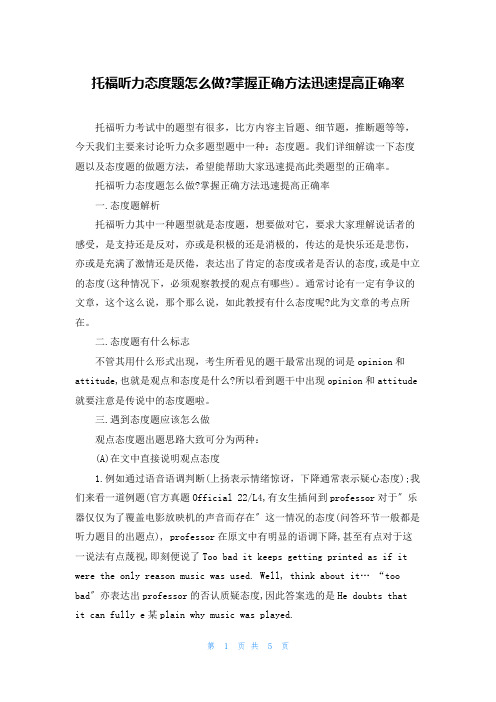
托福听力态度题怎么做?掌握正确方法迅速提高正确率托福听力考试中的题型有很多,比方内容主旨题、细节题,推断题等等,今天我们主要来讨论听力众多题型题中一种:态度题。
我们详细解读一下态度题以及态度题的做题方法,希望能帮助大家迅速提高此类题型的正确率。
托福听力态度题怎么做?掌握正确方法迅速提高正确率一.态度题解析托福听力其中一种题型就是态度题,想要做对它,要求大家理解说话者的感受,是支持还是反对,亦或是积极的还是消极的,传达的是快乐还是悲伤,亦或是充满了激情还是厌倦,表达出了肯定的态度或者是否认的态度,或是中立的态度(这种情况下,必须观察教授的观点有哪些)。
通常讨论有一定有争议的文章,这个这么说,那个那么说,如此教授有什么态度呢?此为文章的考点所在。
二.态度题有什么标志不管其用什么形式出现,考生所看见的题干最常出现的词是opinion和attitude,也就是观点和态度是什么?所以看到题干中出现opinion和attitude 就要注意是传说中的态度题啦。
三.遇到态度题应该怎么做观点态度题出题思路大致可分为两种:(A)在文中直接说明观点态度1.例如通过语音语调判断(上扬表示情绪惊讶,下降通常表示疑心态度);我们来看一道例题(官方真题Official 22/L4,有女生插问到professor对于〞乐器仅仅为了覆盖电影放映机的声音而存在〞这一情况的态度(问答环节一般都是听力题目的出题点), professor在原文中有明显的语调下降,甚至有点对于这一说法有点蔑视,即刻便说了Too bad it keeps getting printed as if it were the only reason music was used. Well, think about it… “too bad〞亦表达出professor的否认质疑态度,因此答案选的是He doubts that it can fully e某plain why music was played.2.通过形容词判断。
托福听力态度题解题技巧实例讲解

托福听力中的态度题想必大家不会陌生,这类题目虽然从难度上来说并不算太高,下面小编就和大家分享托福听力态度题解题技巧实例讲解,希望能够帮助到大家,来欣赏一下吧。
托福听力态度题解题技巧实例讲解先判断正负再做排除托福听力态度题基本出题形式介绍根据托福官方指南OG中的说法,态度题属于pragmatic understandingquestion,也就是所谓的偏向实用理解的题目,简单来说,就是考生可能无法直接在听力中找到完全对应的答案,需要结合自身理解来判断和得出正确答案。
从提问形式上来说,凡是问题中带有attitude,opinion或是infer之类的词,那么这道题目十有89就是问的态度了,常见的提问形式参考如下:What can be inferred about the student?What is the professor's attitude toward X?What is the professor's opinion of X?What can be inferred about the student when she says this?What does the woman mean when she says this?备注:后两种提问形式一般搭配重听题,也就是把问题涉及部分重新放一遍录音的提问形式。
托福听力态度题解题思路实例讲解那么,想要做好托福听力的态度题,考生可以使用哪些比较高效合理的解题技巧呢?小编在这里为大家提供一种划分正负态度来做出判断的技巧思路,先来看例子:What is the student's attitude toward the people he currently work with?A. He finds them boring.B. He likes them.C. He lis annoyed by them.D. He does not have much in common with them.如果按照一般的解题思路,可能考生首先就需要先回忆一下之前听过并记录下来的内容中有没有涉及到态度的部分,之后再去和选项逐一进行比对。
托福听力常见题型解题思路讲解之结构题和态度题
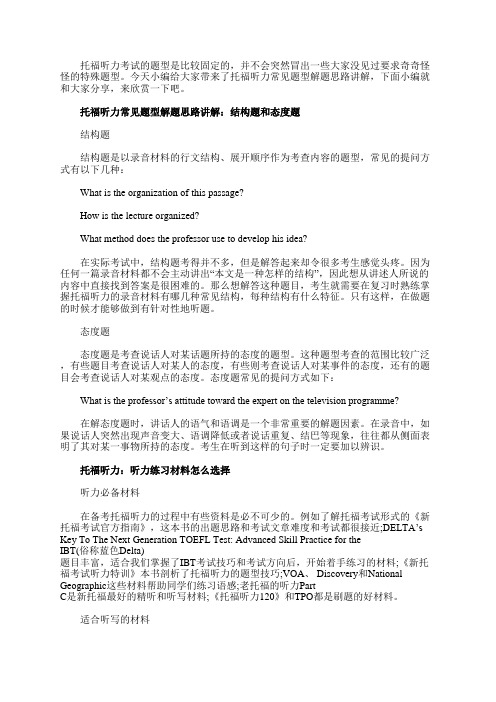
托福听力考试的题型是比较固定的,并不会突然冒出一些大家没见过要求奇奇怪怪的特殊题型。
今天小编给大家带来了托福听力常见题型解题思路讲解,下面小编就和大家分享,来欣赏一下吧。
托福听力常见题型解题思路讲解:结构题和态度题结构题结构题是以录音材料的行文结构、展开顺序作为考查内容的题型,常见的提问方式有以下几种:What is the organization of this passage?How is the lecture organized?What method does the professor use to develop his idea?在实际考试中,结构题考得并不多,但是解答起来却令很多考生感觉头疼。
因为任何一篇录音材料都不会主动讲出“本文是一种怎样的结构”,因此想从讲述人所说的内容中直接找到答案是很困难的。
那么想解答这种题目,考生就需要在复习时熟练掌握托福听力的录音材料有哪几种常见结构,每种结构有什么特征。
只有这样,在做题的时候才能够做到有针对性地听题。
态度题态度题是考查说话人对某话题所持的态度的题型。
这种题型考查的范围比较广泛,有些题目考查说话人对某人的态度,有些则考查说话人对某事件的态度,还有的题目会考查说话人对某观点的态度。
态度题常见的提问方式如下:What is the professor’s attitude toward the expert on the television programme?在解态度题时,讲话人的语气和语调是一个非常重要的解题因素。
在录音中,如果说话人突然出现声音变大、语调降低或者说话重复、结巴等现象,往往都从侧面表明了其对某一事物所持的态度。
考生在听到这样的句子时一定要加以辨识。
托福听力:听力练习材料怎么选择听力必备材料在备考托福听力的过程中有些资料是必不可少的。
例如了解托福考试形式的《新托福考试官方指南》,这本书的出题思路和考试文章难度和考试都很接近;DELTA’s Key To The Next Generation TOEFL Test: Advanced Skill Practice for theIBT(俗称蓝色Delta)题目丰富,适合我们掌握了IBT考试技巧和考试方向后,开始着手练习的材料;《新托福考试听力特训》本书剖析了托福听力的题型技巧;VOA、 Discovery和National Geographic这些材料帮助同学们练习语感;老托福的听力PartC是新托福最好的精听和听写材料;《托福听力120》和TPO都是刷题的好材料。
托福听力常见题型解题思路讲解:结构题和态度题

托福听力考试的题型是比较固定的,并不会突然冒出一些大家没见过要求奇奇怪怪的特殊题型。
今天小编给大家带来托福听力常见题型解题思路讲解,希望能够帮助到大家,下面小编就和大家分享,来欣赏一下吧。
托福听力常见题型解题思路讲解:结构题和态度题结构题结构题是以录音材料的行文结构、展开顺序作为考查内容的题型,常见的提问方式有以下几种:What is the organization of this passage?How is the lecture organized?What method does the professor use to develop his idea?在实际考试中,结构题考得并不多,但是解答起来却令很多考生感觉头疼。
因为任何一篇录音材料都不会主动讲出“本文是一种怎样的结构”,因此想从讲述人所说的内容中直接找到答案是很困难的。
那么想解答这种题目,考生就需要在复习时熟练掌握托福听力的录音材料有哪几种常见结构,每种结构有什么特征。
只有这样,在做题的时候才能够做到有针对性地听题。
态度题态度题是考查说话人对某话题所持的态度的题型。
这种题型考查的范围比较广泛,有些题目考查说话人对某人的态度,有些则考查说话人对某事件的态度,还有的题目会考查说话人对某观点的态度。
态度题常见的提问方式如下:What is the professor’s attitude toward the expert on the television programme?在解态度题时,讲话人的语气和语调是一个非常重要的解题因素。
在录音中,如果说话人突然出现声音变大、语调降低或者说话重复、结巴等现象,往往都从侧面表明了其对某一事物所持的态度。
考生在听到这样的句子时一定要加以辨识。
2020托福听力练习:害羞的鱼类更喜欢追随同样胆小的鱼When you think of a leader, you may think of an individual who is above all bold. But a new study of fish called sticklebacks shows that shy individuals actually prefer to follow fish that are similarly timid.Researchers had trios of sticklebacks with known personalities play follow the leader. The fish were placed in a tank that had some plastic plants at one end and some food hidden at the other. In some of the groups, a bold fish and a shy fish acted as leaders, while another shy fish followed. And in other groups, it was a bold fish that did the following. The researchers recorded whether the follower sallied forth more frequently with the fish that was behaviorally similar or the one that was different.What they found is that shy fish were more likely to emerge from under cover when an equally wary fellow was already out there. Bold follower fish did not seem to care which leader they followed.Of course, no matter which fish a stickleback chose to stick with, the bold fish did lead more expe ditions over the course of the experiment than their more retiring friends. That’s because the bold fish initiated more trips, regardless of who might be tailing them. The findings are in the journal Biology Letters.The researchers write that "when offered a choice of leaders, sticklebacks prefer to follow individuals whose personality matches their own, but bolder individuals may, nevertheless, be able to impose their leadership, even among shy followers, simply through greater effort." We may soon see if such tendencies also hold true in humans, when Americans decide who they’ll follow in November. Unless, of course, something fishy happens.你可能认为领导者通常都是非常大胆的个体。
托福听力态度题直接间接态度提示信号词整理解析

托福听力态度题直接间接态度提示信号词整理解析托福听力中态度题是高频常考题型,这种题型的特点在于答案不会直接给出,需要考生自己根据听力中的各种提示来进行判断。
下面就给大家带来托福听力态度题直接间接态度提示信号词整理解析,希望能够帮助到大家,一起来学习吧。
托福听力态度题直接间接态度提示信号词整理解析托福听力态度题信号词整理解读:直接态度①说话人的语气语调听力中,最为直接的跟说话人态度相关的提示就是说话人的语气。
常见的语气如:疑问,惊讶(Really? /I couldn’t believe…/JesusChrist!/Wow!/Oh, my God! /Gosh!/ What!),重读,放慢语速,停顿,怀疑,犹豫(Um...),可惜(whata shame/ that’s too bad./ I’m sorry to hear that)等等。
②形容词等评价性内容在听力中,不是所有的形容词都要记下来。
考生们需要记录的是有感情色彩的形容词。
常见的形容词如下:积极正面:favorable,approval,interesting,enthusiastic,supportive,great,magnif icent,glamorous,excellent,fantastic,outstanding,terrific,awesome,a mazing,charming...消极负面:disapproval,dissatisfied,boring,suspicious,critical,bad,skeptical,ques tionable...中立客观:neutral,unprejudiced,impartial,unbiased...托福听力态度题信号词整理解读:间接态度①一语双关在托福听力中,说话人有些话没有直接表达出实际意思,需要考生结合上下文语境去理解。
②委婉表达有的时候,说话人会通过委婉表达的方式阐明自己的意见,比如教授提问学生时,学生的回答并不完全正确,此时教授就会通过引导的方式,委婉的表达学生回答错误这个信息。
托福听力态度题解析
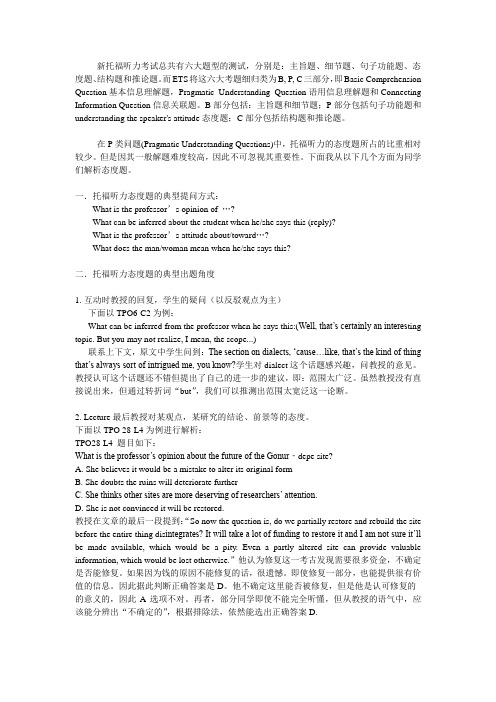
新托福听力考试总共有六大题型的测试,分别是:主旨题、细节题、句子功能题、态度题、结构题和推论题。
而ETS将这六大考题细归类为B, P, C三部分,即Basic Comprehension Question基本信息理解题,Pragmatic Understanding Question语用信息理解题和Connecting Information Question信息关联题。
B部分包括:主旨题和细节题;P部分包括句子功能题和understanding the speaker's attitude态度题;C部分包括结构题和推论题。
在P类问题(Pragmatic Understanding Questions)中,托福听力的态度题所占的比重相对较少。
但是因其一般解题难度较高,因此不可忽视其重要性。
下面我从以下几个方面为同学们解析态度题。
一.托福听力态度题的典型提问方式:What is the professor’s opinion of …?What can be inferred about the student when he/she says this (reply)?What is the professor’s attitude about/toward…?What does the man/woman mean when he/she says this?二.托福听力态度题的典型出题角度1.互动时教授的回复,学生的疑问(以反驳观点为主)下面以TPO6-C2为例:What can be inferred from the professor when he says this:(Well, that’s certainly an interes ting topic. But you may not realize, I mean, the scope...)联系上下文,原文中学生问到:The section on dialects, ‘cause…like, that’s the kind of thing that’s always sort of intrigued me, you know?学生对dialect这个话题感兴趣,问教授的意见。
新托福考试听力测试经典型:句子功能题+态度题
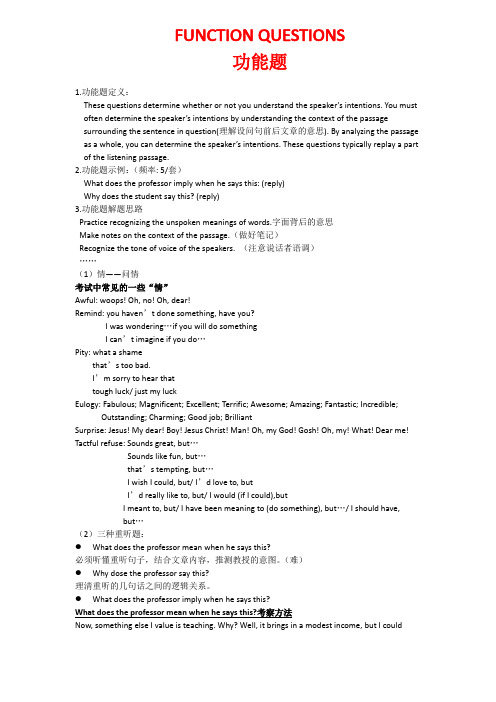
FUNCTION QUESTIONS功能题1.功能题定义:These questions determine whether or not you understand the speaker’s intentions. You must often determine the speaker’s intentions by understanding the context of the passage surrounding the sentence in question(理解设问句前后文章的意思). By analyzing the passage as a whole, you can determine the speaker’s intentions. These questions typically replay a part of the listening passage.2.功能题示例:(频率: 5/套)What does the professor imply when he says this: (reply)Why does the student say this? (reply)3.功能题解题思路Practice recognizing the unspoken meanings of words.字面背后的意思Make notes on the context of the passage.(做好笔记)Recognize the tone of voice of the speakers. (注意说话者语调)……(1)情——问情考试中常见的一些“情”Awful: woops! Oh, no! Oh, dear!Remind: you haven’t done something, have you?I was wondering…if you will do somethingI can’t imagine if you do…Pity: what a shamethat’s too bad.I’m sorry to hear thattough luck/ just my luckEulogy: Fabulous; Magnificent; Excellent; Terrific; Awesome; Amazing; Fantastic; Incredible;Outstanding; Charming; Good job; BrilliantSurprise: Jesus! My dear! Boy! Jesus Christ! Man! Oh, my God! Gosh! Oh, my! What! Dear me! Tactful refuse: Sounds great, but…Sounds like fun, but…that’s tempting, but…I wish I could, but/ I’d love to, butI’d really like to, but/ I would (if I could),butI meant to, but/ I have been meaning to (do something), but…/ I should have,but…(2)三种重听题:●What does the professor mean when he says this?必须听懂重听句子,结合文章内容,推测教授的意图。
托福听力态题结构题功能题解析
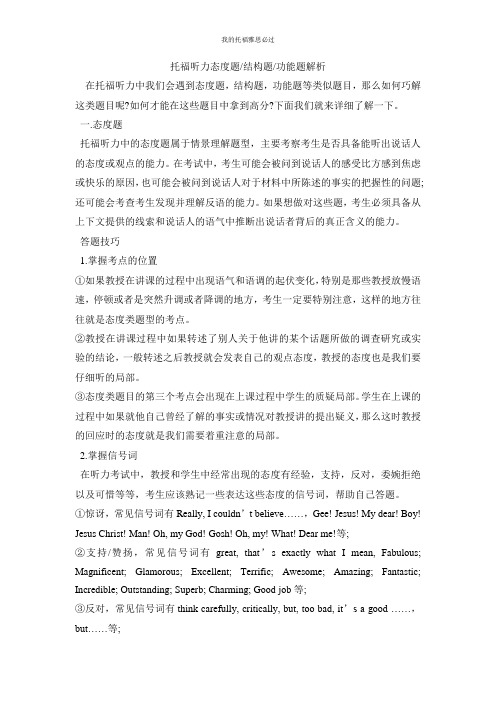
托福听力态度题/结构题/功能题解析在托福听力中我们会遇到态度题,结构题,功能题等类似题目,那么如何巧解这类题目呢?如何才能在这些题目中拿到高分?下面我们就来详细了解一下。
一.态度题托福听力中的态度题属于情景理解题型,主要考察考生是否具备能听出说话人的态度或观点的能力。
在考试中,考生可能会被问到说话人的感受比方感到焦虑或快乐的原因,也可能会被问到说话人对于材料中所陈述的事实的把握性的问题;还可能会考查考生发现并理解反语的能力。
如果想做对这些题,考生必须具备从上下文提供的线索和说话人的语气中推断出说话者背后的真正含义的能力。
答题技巧1.掌握考点的位置①如果教授在讲课的过程中出现语气和语调的起伏变化,特别是那些教授放慢语速,停顿或者是突然升调或者降调的地方,考生一定要特别注意,这样的地方往往就是态度类题型的考点。
②教授在讲课过程中如果转述了别人关于他讲的某个话题所做的调查研究或实验的结论,一般转述之后教授就会发表自己的观点态度,教授的态度也是我们要仔细听的局部。
③态度类题目的第三个考点会出现在上课过程中学生的质疑局部。
学生在上课的过程中如果就他自己曾经了解的事实或情况对教授讲的提出疑义,那么这时教授的回应时的态度就是我们需要着重注意的局部。
2.掌握信号词在听力考试中,教授和学生中经常出现的态度有经验,支持,反对,委婉拒绝以及可惜等等,考生应该熟记一些表达这些态度的信号词,帮助自己答题。
①惊讶,常见信号词有Really, I couldn’t believe……,Gee! Jesus! My dear! Boy! Jesus Christ! Man! Oh, my God! Gosh! Oh, my! What! Dear me!等;②支持/赞扬,常见信号词有great, that’s exactly what I mean, Fabulous; Magnificent; Glamorous; Excellent; Terrific; Awesome; Amazing; Fantastic; Incredible; Outstanding; Superb; Charming; Good job等;③反对,常见信号词有think carefully, critically, but, too bad, it’s a good ……,but……等;④委婉拒绝,常见信号词有Sounds great, but/ Sounds like fun, but/ that’s tempting, but/ I wish I could, but/ I’d love to, but/ I’d really like to, but/I would (if I could), but/ I meant to, but/ I have been meaning to (do something), but/ I should have, but…等;⑤可惜,常见信号词有what a shame/ that’s too bad./ I’m sorry to hear that/ tough luck等;3.积累反语词汇反语往往表达的意思和本意相反,而且含有否认、挖苦以及嘲弄的意思,是一种带有强烈感情色彩的修辞方法。
- 1、下载文档前请自行甄别文档内容的完整性,平台不提供额外的编辑、内容补充、找答案等附加服务。
- 2、"仅部分预览"的文档,不可在线预览部分如存在完整性等问题,可反馈申请退款(可完整预览的文档不适用该条件!)。
- 3、如文档侵犯您的权益,请联系客服反馈,我们会尽快为您处理(人工客服工作时间:9:00-18:30)。
新托福听力考试总共有六大题型的测试,分别是:主旨题、细节题、句子功能题、态度题、结构题和推论题。
而ETS将这六大考题细归类为B, P, C三部分,即Basic Comprehension Question基本信息理解题,Pragmatic Understanding Question语用信息理解题和Connecting Information Question信息关联题。
B部分包括:主旨题和细节题;P部分包括句子功能题和understanding the speaker's attitude态度题;C部分包括结构题和推论题。
在P类问题(Pragmatic Understanding Questions)中,托福听力的态度题所占的比重相对较少。
但是因其一般解题难度较高,因此不可忽视其重要性。
下面我从以下几个方面为同学们解析态度题。
一.托福听力态度题的典型提问方式:
What is the professor’s opinion of …?
What can be inferred about the student when he/she says this (reply)?
What is the professor’s attitude about/toward…?
What does the man/woman mean when he/she says this?
二.托福听力态度题的典型出题角度
1.互动时教授的回复,学生的疑问(以反驳观点为主)
下面以TPO6-C2为例:
What can be inferred from the professor when he says this:(Well, that’s certainly an interes ting topic. But you may not realize, I mean, the scope...)
联系上下文,原文中学生问到:The section on dialects, ‘cause…like, that’s the kind of thing that’s always sort of intrigued me, you know?学生对dialect这个话题感兴趣,问教授的意见。
教授认可这个话题还不错但提出了自己的进一步的建议,即:范围太广泛。
虽然教授没有直接说出来,但通过转折词“but”,我们可以推测出范围太宽泛这一论断。
2. Lecture最后教授对某观点,某研究的结论、前景等的态度。
下面以TPO 28-L4为例进行解析:
TPO28-L4 题目如下:
What is the professor’s opinion about the future of the Gonur‐depe site?
A. She believes it would be a mistake to alter its original form
B. She doubts the ruins will deteriorate further
C. She thinks other sites are more deserving of researchers’ attention.
D. She is not convinced it will be restored.
教授在文章的最后一段提到:“So now the question is, do we partially restore and rebuild the site before the entire thing dis integrates? It will take a lot of funding to restore it and I am not sure it’ll be made available, which would be a pity. Even a partly altered site can provide valuable information, which would be lost otherwise.”他认为修复这一考古发现需要很多资金,不确定是否能修复。
如果因为钱的原因不能修复的话,很遗憾。
即使修复一部分,也能提供很有价值的信息。
因此据此判断正确答案是D。
他不确定这里能否被修复,但是他是认可修复的的意义的,因此A选项不对。
再者,部分同学即使不能完全听懂,但从教授的语气中,应该能分辨出“不确定的”,根据排除法,依然能选出正确答案D.
3. 情感信号词(形容词或副词的感情色彩)、语气语调的起伏变化(重音、放慢语速或停顿)。
我们以TPO 25-L3 为例:
TPO 25-L3题目如下:
What is the professor’s opinion about Thomas Young’s word with hieroglyphs?
A. She feels that Young has not received the credit he deserves
B. She is amazed that Young’s conclusion about hieroglyphs was correct
C. She is surprised that Young did not recognize his own accomplishments
D. She thinks that Y oung’s work was not careful enough to be taken seriously
原文有明显的情感信号词,揭示教授的态度:“Strangely though, he gave into the dominant thesis of the day that hieroglyphs were pictographs. He actually dismissed his own findings as an anomaly......”, 只要同学们注意到情感信号词,此题就迎刃而解了。
以上是我对态度题的解析,希望对同学们有所帮助。
祝同学们早日取得优异的成绩!。
